Agriculture (including its effect on land use change) represents a significant component of the NDC in many countries. Yet to successfully implement the agricultural component of an NDC, policymakers need to better understand the likely impacts of climate change on agriculture, as well as the potential savings in greenhouse gas (GHG) emissions from different policy and investment options. […]
GCAN Presentation on Aflatoxin Hotspot modeling at USAID – October 2018
On October 22, Timothy Thomas presented “Aflatoxins and Climate Change: Preliminary Results from a New Biophysical Model for Groundnuts and Selected FTF Countries” at USAID. The presentation focused on groundnut production in Burkina Faso and Niger. The main results are presented in Table 1, which shows the normal aflatoxin concentration at the national level with and without climate change. […]
Knowledge Lab on Climate Resilient Food Systems
Food systems fundamentally influence the environment of the planet, the livelihoods of billions of people (including most of the world’s poor), and the nutrition of every human being. Robust food systems can serve as catalysts for achieving the Sustainable Development Goals, but their current weaknesses are a major source of vulnerability to a variable and changing climate. IFPRI’s Knowledge […]
Gender-Sensitive, Climate-Smart Agriculture for Improved Nutrition in Africa South of the Sahara
Chapter 9 of the 2016 ReSAKSS Annual Trends and Outlook Report tackles the nexus of CSA, gender, and nutrition, providing an integrated conceptual framework with entry points for action as well as information requirements to guide interventions in the context of climate change. The authors clearly argue that to go beyond incremental approaches to adaptation, these […]
The effect of climate change across food systems: Implications for nutrition outcomes
A better understanding of the pathways linking climate change and nutrition is critical for developing effective interventions to ensure the world's population has access to sufficient, safe, and nutritious food. The paper uses a food systems approach to analyze the bidirectional relationships between climate change and food and nutrition along the entire food supply chain. It identifies adaptation […]
- 1
- 2
- 3
- …
- 7
- Next Page »



